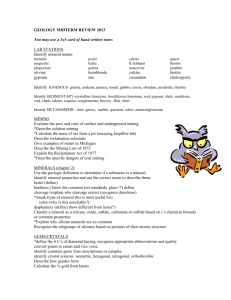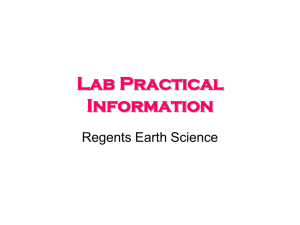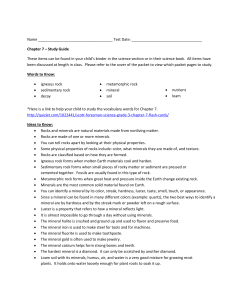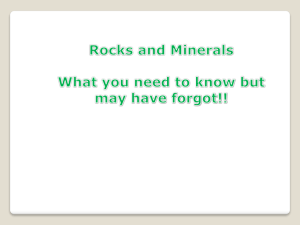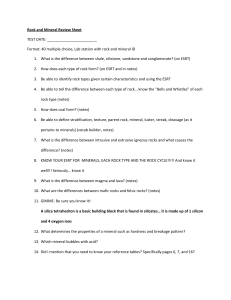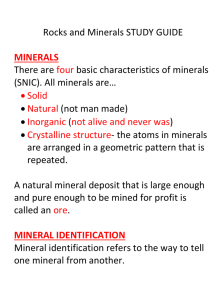Geo 102 Practice Exam 1
advertisement
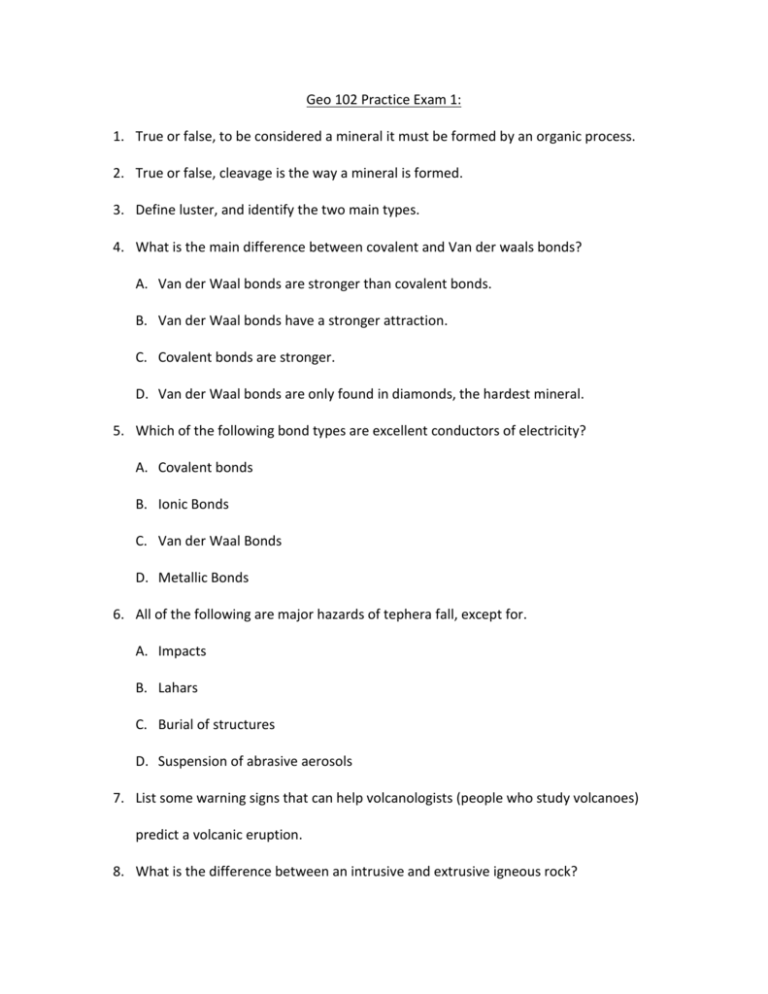
Geo 102 Practice Exam 1: 1. True or false, to be considered a mineral it must be formed by an organic process. 2. True or false, cleavage is the way a mineral is formed. 3. Define luster, and identify the two main types. 4. What is the main difference between covalent and Van der waals bonds? A. Van der Waal bonds are stronger than covalent bonds. B. Van der Waal bonds have a stronger attraction. C. Covalent bonds are stronger. D. Van der Waal bonds are only found in diamonds, the hardest mineral. 5. Which of the following bond types are excellent conductors of electricity? A. Covalent bonds B. Ionic Bonds C. Van der Waal Bonds D. Metallic Bonds 6. All of the following are major hazards of tephera fall, except for. A. Impacts B. Lahars C. Burial of structures D. Suspension of abrasive aerosols 7. List some warning signs that can help volcanologists (people who study volcanoes) predict a volcanic eruption. 8. What is the difference between an intrusive and extrusive igneous rock? 9. What is the difference between lava and magma? 10. A pyroclastic flow is. A. A fire down the side of a mountain B. Avalanches of hot, dry, volcanic rock fragments, and gases, denser than air. C. Hot and cold liquid of debris D. Mixture of hot gases and fragments that are less dense than air. 11. Which type of viscosity is associated with non-explosive volcanoes? 12. What are the differences between the three types of plate boundaries? 13. All of the following are requirements to be a mineral, except for. A. Naturally formed B. Solid C. Characteristic crystal structure D. Indistinct chemical compositions E. Formed by an inorganic process 14. List the properties of a mineral (hint: there are 8). 15. What is the most common element in the earth? A. Carbon Dioxide B. Hydrogen C. Water D. Oxygen 16. An ion with a positive charge is called a. A. Cation B. Anion C. Positivion D. Isotope 17. An anion has what kind of charge. A. Positive B. Neutral C. Both positive and negative D. Negative 18. True or false, Isotopes are elements with a different number of electrons in their nucleus. 19. Define a rock. 20. What are the two main types of igneous rocks and what is the main difference between them? 21. What are the three main categories of rocks? A. Igneous, Sedimentary, and Metamorphic B. Igneous, Limestone, and Metamorphic C. Granite, Coal, and Diamonds D. Igneous, Fossils, and Metamorphic 22. What are the three factors that control the melting of an igneous rock? A. Temperature, Pressure, and Mineral composition B. Water content, Pressure, and Time C. Location, Heat, and Energy D. Temperature, Pressure, and Water content 23. What is the difference between Phaneritic and Aphanitic rock textures? 24. What is rock texture related to? A. Chemistry of rocks and minerals B. How hard a rock is C. Water content D. Cooling History 25. True or false, Mafic rocks are high in iron and magnesium, but low in silica content. 26. True or false, explosive volcanoes have high viscosity magma. 27. Scenario: You are a prominent Volcanologist and are studying a volcano that is on the verge of an eruption. You are trying to determine which type of volcano it is and whether it will be an explosive of non-explosive eruption. Here are your clues: basaltic magama, low sio2 gas content, and has a low viscosity. Good luck! 28. What is the difference between high and low viscosity? 29. The rate at which temperature increases with depth is known as: A. Partial Melting B. Plate Tectonics C. Geothermal Gradient D. Bowen’s Reaction Series 30. According to Bowen’s reaction series what type of rocks will crystallize (cool) first and which will crystallize last? 31. True or false, as pressure increases, melting temperature decreases. 32. True or false, as water content increases melting temperature of igneous rocks decreases. 33. List some lines of evidence for continental drift. 34. Who came up with the theory of continental drift? A. Michael Jordan B. Ben Franklin C. Alfred Wegener D. James Hutton 35. What were two failed theories concerning plate tectonics? 36. Define Geology. 37. What are the parts of an atom? A. Proton, Neutron, Electron B. Anion, Proton, Electron C. Cation, Anion, Isotope, D. Proton, Neutron, Isotope 38. True or false, the stronger a bond the harder a mineral. 39. Which type of volcano occurs at hot spots and are not associated with plate boundaries? A. Composite B. Caldera C. Flood Basalt D. Shield 40. List the types of volcanoes. 41. This volcano is explosive, has steep sides, a high silica magma, and a high viscosity. A. Caldera B. Shield C. Composite/strato D. Flood Basalt 42. What are lava flows controlled by? A. Water content B. Topography C. Pressure D. Temperature 43. What are the two main types of weathering, and give examples of both. 44. When one ion replaces another, and the minerals inside a rock become more stable this is known as. A. Ion exchange B. Oxidation C. Frost Wedging D. Disolution 45. What does radioactive decay deep inside the cause? A. Rocks to form B. Rocks to melt C. Nothing D. Magnetic Field to increase 46. Volcanic explosions that eject rock fragments during an eruption or independently from an eruption are called. A. Cannon Balls B. Bombs C. Tephera D. Ballistic Projectiles 47. What are the three types of tephra fall? 48. A type of chemical weathering that changes the oxidation state of atoms within a rock to a more stable form is. A. Disolution B. Oxidation C. Ion exchange D. Salt Wedging 49. Which type of chemical weathering breaks apart a mineral into ions? A. Oxidation B. Ion exchange C. Hydrolysis D. Disolution 50. Define regolith. 51. The top half of regolith that has experienced continued weathering is. A. Soil B. Regolith C. Minerals D. Clay 52. Define Talus. 53. All of the following are ways that water and wind transport sediments, except for. A. Saltation B. Bed load C. Blowing D. Suspension 54. True or false, ice can transport sediments and sort them. 55. Define striations in rocks, and what is the difference from mineral striations? 56. True or false, suspension moves the least material in a stream. 57. Define plate tectonics and what drives it. 58. What type of plate boundary forms rift valleys? A. Convergent B. Divergent C. Transform 59. True or false, continental crust is older than oceanic crust. 60. What is Pangaea?


